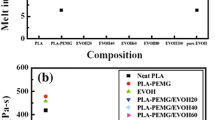Abstract
Using the extrusion blown film process, we obtained linear low density polyethylene (LLDPE)/ethylenevinyl alcohol copolymer (EVOH) blends with an improved barrier property by generating a laminar structure of the dispersed phase in the matrix phase. This laminar morphology induced by drawing and blowing was found to result in a significant decrease in toluene permeability with only 10 wt% EVOH. Effects of compatibilizer content and processing parameters such as blending sequence, screw configuration, and stretch ratio on the toluene permeability and morphology of the blends were investigated. It was revealed that the optimum amount of compatibilizer, maleic anhydride grafted LLDPE, should be used to improve the barrier property of the LLDPE/EVOH blends with a well developed laminar structure. The blending sequence had a significant influence on the permeability of the blends. The blend films exhibited a more pronounced laminar structure when all blend components were simultaneously melt blended in a single screw extruder. In addition, the screw configuration designed to impart a low shear stress and the balanced stretching in the machine and transverse directions were more favorable processing conditions in obtaining high barrier blends.
Similar content being viewed by others
References
Botros, M. G., “Investigation of Adhesion and Failure Mechanism in Tie-Layer Adhesive/EVOH Systems,”J. Plastic Film & Sheeting,12, 195 (1996).
Faisant, J. B., Kadi, A. A., Bousmina, M. and Deschenes, L., “Morphology, Thermomechanical and Barrier Properties of Polypropylene-Ethylene Vinyl Alcohol Blends,”Polymer,39(3), 533 (1998).
Favis, B. D. and Chalifoux, J. P., “The Effect of Viscosity Ratio on the Morphology of Polypropylene/Polycarbonate Blends During Processing,”Polym. Eng. Sci.,27(20), 1591 (1987).
Finch, C. A., “Polyvinyl Alcohol,” John Wiley and Sons, New York (1993).
Finlayson, K. M., “Plastic Film Technology: High Barrier Plastic Films for Packaging,” Technomic Publishing Co., Lancaster, Pa. (1989).
Gonzalez-Nunez, R., Favis, B. D., Carreau, P. J. and Lavallee, C., “Factors Influencing the Formation of Elongated Morphologies in Immiscible Polymer Blends During Melt Processing,”Polym. Eng. Sci.,33(13), 851 (1993).
Holsti-Meittinen, R. M., Perttila, K. P., Seppala, J. V. and Heino, M. T., “Oxygen Barrier Properties of Polypropylene/Poly amide 6 Blends,”J. Appl. Polym. Sci.,58, 1551 (1995).
Hope, P. S., Bonner, J. G. and Curry, J. E., “A Collaborative Study of the Structure and Rheological Properties of EVOH/SMA Blends Produced by Reactive Extrusion,”Pure & Appl. Chem.,68(8), 1665 (1996).
Kamal, M. R., Garmabi, H., Hozhabr, S. and Arghyris, L., “The Development of Laminar Morphology During Extrusion of Polymer Blends,”Polym. Eng Sci.,35(1), 41 (1995).
Kamal, M. R., Jinnah, I. A. and Utracki, L. A., “Permeability of Oxygen and Water Vapor Through Polyethylene/Polyamide Films,”Polym. Eng Sci.,24(17), 1337 (1984).
Lee, S. Y. and Kim, S. C., “Laminar Morphology Development and Oxygen Permeability of LDPE/EVOH Blends,”Polym. Eng. Sci.,37(2), 463 (1997).
Lohfink, G. W. and Kamal, M. R., “Morphology and Permeability in Extruded Polypropylene/Ethylene Vinyl-Alcohol Copolymer Blends,”Polym. Eng Sci.,33(21), 1404 (1993).
Min, K., White, J. L. and Fellers, J. F., “Development of Phase Morphology in Incompatible Polymer Blends during Mixing and Its Variation in Extrusion,”Polym. Eng. Sci.,24(17), 1327 (1984).
Samios, C. K. and Kalfoglou, N. K., “Compatibilization of poly(ethylene-co-vinyl alcohol) (EVOH) and EVOH/HDPE Blends with Ionomers. Structure and Properties,”Polymer,39(16), 3863 (1998).
Subramanian, P. M., “Permeability Barriers by Controlled Morphology of Polymer Blends,”Polym. Eng. Sci.,25(8), 483 (1985).
Subramanian, P. M. and Mehra, V., “Laminar Morphology in Polymer Blends: Structure and Properties,”Polym. Eng. Sci.,27(9), 663 (1987).
Wu, S., “Formation of Dispersed Phase in Incompatible Polymer Blends: Interfacial and Rheological Effects,”Polym. Eng. Sci.,27(5), 335 (1987).
Author information
Authors and Affiliations
Corresponding author
Rights and permissions
About this article
Cite this article
Kim, S.W., Chun, Y.H. Barrier property by controlled laminar morphology of LLDPE/EVOH blends. Korean J. Chem. Eng. 16, 511–517 (1999). https://doi.org/10.1007/BF02698277
Received:
Accepted:
Issue Date:
DOI: https://doi.org/10.1007/BF02698277




